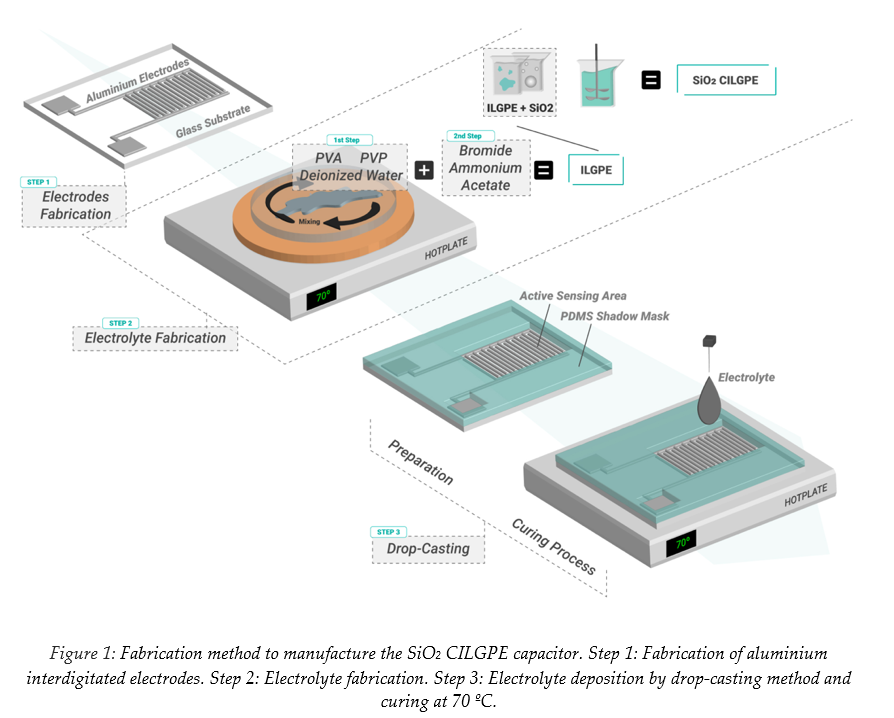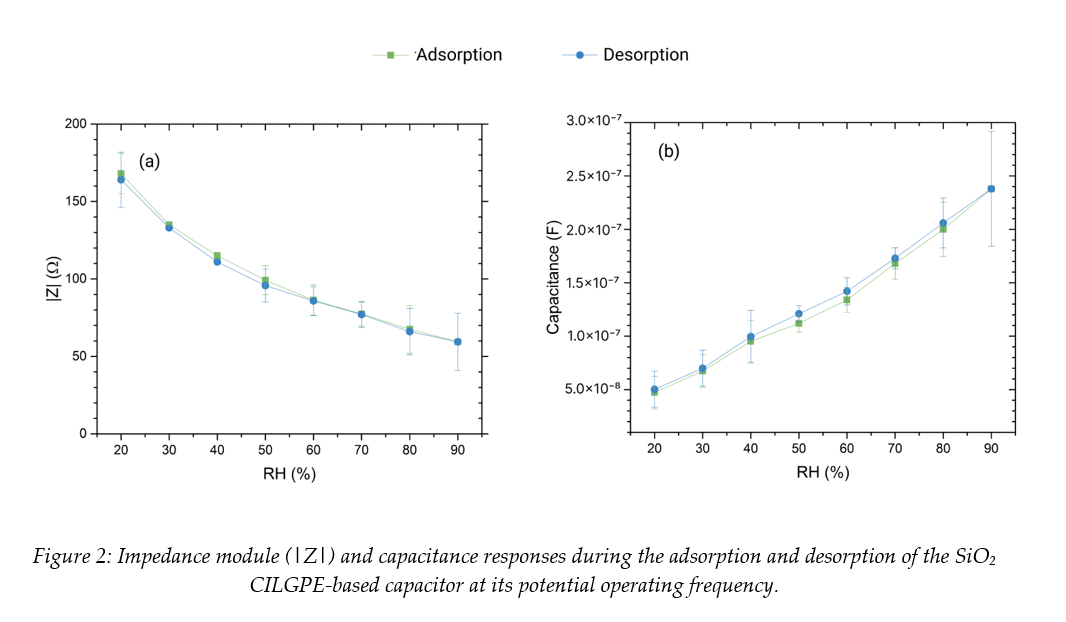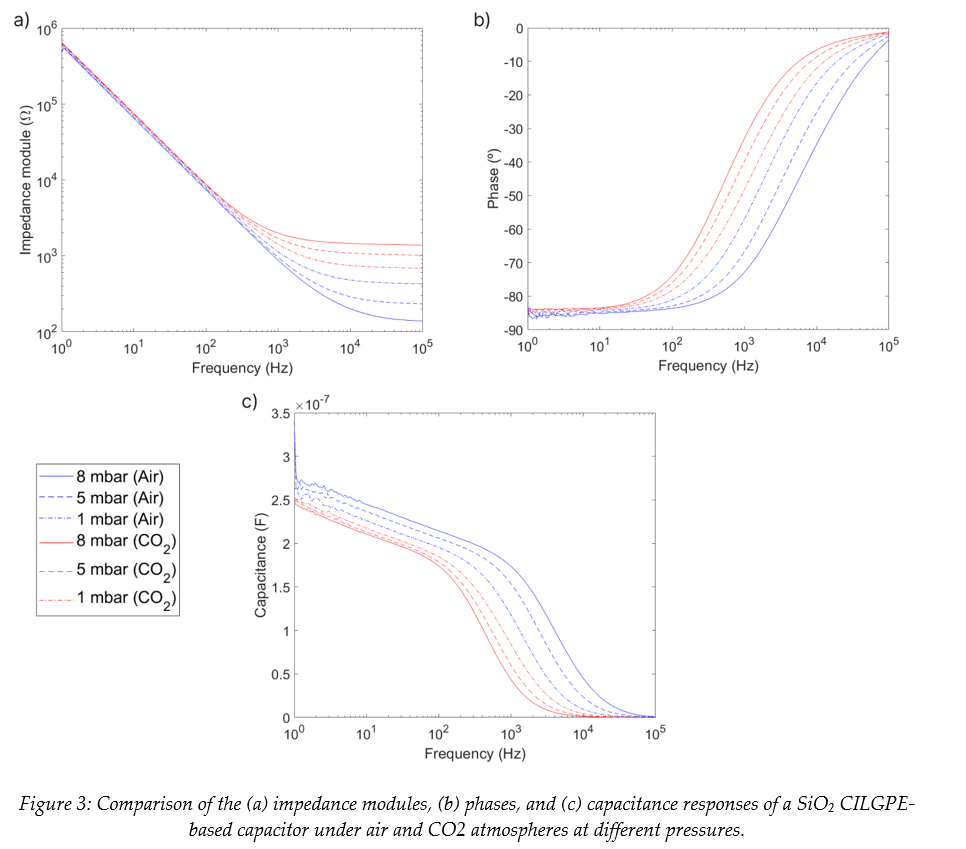Electrochemical impedance spectroscopy analysis of a SiO2 submicron-particles-based relative humidity sensor for planetary research applications
- Polytechnic University of Catalonia, Barcelona, Spain (kristel.michell.cedeno@upc.edu)
Purpose
This work presents the development and analysis of a SiO2 composite ionic liquid gel polymer electrolyte (SiO2-CILGPE)-based capacitor in air and carbon dioxide (CO2) atmospheres. The effectiveness of the proposed layer as a humidity-sensitive layer has been demonstrated in [1]. Its use as a humidity sensing layer not only stands out among other alternatives due to its sensing performance, but also because of its cost-effectiveness, scalability, and non-toxicity. In this realm, this study exhibits a brief comparison of the impedance characteristics of the proposed device under air and CO2 conditions, aiming to examine a first insight into the impact of CO2 onits electrical behaviour to evaluate its potential use as a relative humidity sensor for planetary research applications, such the ones carried out in Mars for habitability studies.
Methodology
Figure 1 illustrates the fabrication process of the SiO2 CILGPE. The fabrication starts by dissolving the host polymers (HPs) in deionised water at 70 ºC. Then, a blend of CH₃COONH₄ and 1-Butyl-3-methylimidazolium bromide is incorporated and stirred at 70 ºC. Afterwards, SiO₂ nanoparticles are embedded in the resultant ILGPE using an ultrasound bath until a homogenous mixture is achieved. Finally, the resulting electrolyte is deposited onto the active electrode area using drop-casting and subsequently cured, forming a layer with a thickness of around 600 μm and length and width of 0.4 mm and 1mm, respectively.
The humidity sensing performance of the SiO2 CILGPE-based capacitor was evaluated using the electrochemical impedance spectroscopy (EIS) technique under different humidity conditions at atmospheric pressure. The impedimetric response has been obtained using the impedance module values, while the capacitance response has been calculated using Equation 1:
C = -𝑍′′/( 2𝜋 𝑓𝑍2) (Eq. 1)
Where 𝑍 and 𝑍′′ are the module and imaginary part of the impedance, respectively.
Furthermore, EIS measurements under air and CO2 conditions at different pressures have been carried out and compared to evaluate its behaviour under a CO2 atmosphere. This evaluation starts with air evacuation until a partial vacuum, reducing the concentration of air. This first part of the process provides information about the impact of pressure variations on the electrical behaviour of the SiO2 CILGPE-based capacitor under air conditions. Once 0.1 mbar is reached, CO2 is injected in a controlled and gradual manner. This second step stimulates an increase in the internal pressure of the chamber and allows a preliminary analysis of how the quantity of CO2 can impact the impedimetric characteristics of the device. This methodology enables the characterisation of the SiO2-CILGPE-based capacitor under different conditions of pressure and gas composition, thereby providing initial insights into how the presence of different gases affects its performance. The exhibited EIS measurements can be fitted using the equivalent circuit (EC) displayed in Figure 4. The analysis of EIS data from ECs could allow a first insight into the understanding of the impact of CO2 on the sensing mechanism and performance of the SiO2 CILGPE-based capacitor.
Results
Figure 2 illustrates the obtained Z and capacitance humidity sensing responses. As can be noticed, the SiO2 CILGPE-based capacitor reveals changes in two parameters, increasing its reliability compared to other relative humidity sensors in the literature and offering more information that could facilitate the calibration process.
Following the analysis of the EIS data, Figure 3 compares the obtained impedance module, phase, and capacitance spectra under air and CO2 atmospheres. It is noticeable that the curves of the three parameters of the SiO2 CILGPE-based capacitor exhibit the same trend under the presence of both gases, thereby suggesting the SiO2 CILGPE layer could work similarly under air and CO2.
Nevertheless, the characterised parameters reveal opposite shifts in response to pressure variations. Firstly, under an air atmosphere, it can be noticed that a reduction in the pressure implies an increase in the impedance module and a decrease in the capacitance. This behaviour could be ascribed to a reduction of the water vapour molecules since reducing the pressure inside the measurement chamber also implies a reduction in the partial pressure of all gases, including water vapour [2]. Reducing the water molecules promotes a decrease in the number of charge carriers within the humidity-sensitive layer and, hence, an increase in the impedance and a decrease in the capacitance. Conversely, under a CO2 atmosphere, the SiO2 CILGPE-based capacitor depicts an increase in the impedance module values and a reduction in the capacitance when increasing the pressure. This finding might be attributed to the injection of CO2 into the vacuumed chamber. One possible explanation for such phenomena is that introducing CO2 into the chamber increases the pressure, thereby could reduce the water vapour concentration relative to the total gas, promoting a decrease in the relative humidity. Consequently, the obtained impedance spectra suggest that the SiO2 CILGPE-based capacitor could possess the same response to relative humidity variations under the presence of air and CO2. Further research should focus on investigating and analysing the impact of CO2 presence under different relative humidity levels.
Conclusions
EIS measurements show that, under air and CO2 conditions, the SiO2 CILGPE-based capacitor exhibits similar impedance, phase, and capacitance curve trends, thereby suggesting the SiO2 CILGPE layer could operate following similar electrical behaviours under CO2. Additionally, this comparison shows that a reduction in the relative humidity could imply the same response under air and CO2 atmospheres. Therefore, it might suggest that CO2 does not alter the dominant sensing mechanism.
Consequently, this work provides first insights into the possible potential of a non-toxic, cost-effective alternative based on a SiO2 CILGPE as a sensing layer for humidity sensing in CO2 atmospheres.
Acknowledgements
This work has been supported by the projects TED2021-131552B-C22 and PID2021-126719OB-C42.
References
- [1] Cedeño Mata, M.; Orpella, A.; Dominguez-Pumar, M.; Bermejo, S. Boosting the Sensitivity and Hysteresis of a Gel Polymer Electrolyte by Embedding SiO2 Nanoparticles and PVP for Humidity Applications. Gels 2024, 10, 50, doi:10.3390/gels10010050.
- [2] McIntosh, D. H. and A. S. Thom, Essentials of Meteorology, 1978, Wykeham Publications.




How to cite: Cedeño, M., Palomas, A., Manyosa, X., Coloma, A., Domínguez-Pumar, M., and Bermejo, S.: Electrochemical impedance spectroscopy analysis of a SiO2 submicron-particles-based relative humidity sensor for planetary research applications, Europlanet Science Congress 2024, Berlin, Germany, 8–13 Sep 2024, EPSC2024-936, https://doi.org/10.5194/epsc2024-936, 2024.